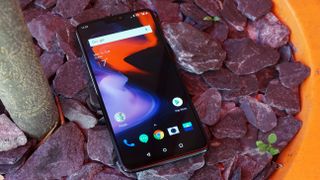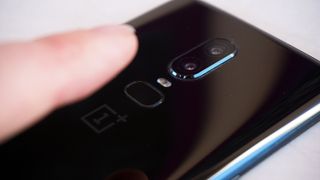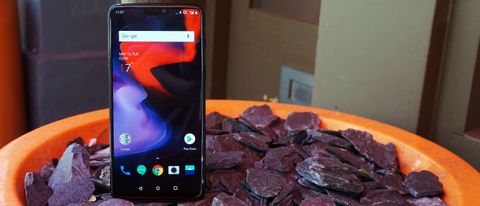Why you can trust TechRadar

It's SO FAST!
Qualcomm's flagship chipsets are impressively fast nowadays, but not every Android OEM makes use of them as effectively as OnePlus. The company makes a big deal of how it goes the extra mile to make this phone feel buttery smooth, and I have to agree.
Last year's OnePlus 5T was faster than the Pixel 2, and this year's OnePlus 6 is the fastest Android phone on the market right now. I say that having come right off a Samsung Galaxy S9 Plus and Huawei P20 Pro. Neither of those companies tunes the software with as much precision as OnePlus does.
I'm not saying this phone doesn't lag at times. That's unfortunately, a bane of the Android ecosystem. Yet, the micro-lags that I did find are rarer on the OnePlus 6 than any other phone. As with any other phone, the OnePlus 6 is prone to heating in Delhi's summer. And the few lags I saw were while playing Marvel: Contest of Champions out in the heat.
The game in question is important because Contest of Champions doesn't just use the GPU. It also runs network operations constantly when you're playing, putting a greater load on the whole device. If you're playing a game like Asphalt 8, which is capped to 30fps frame rates, this phone is buttery smooth.
The OnePlus 6 moves between WiFi and LTE without a hitch and it loads apps faster than any Android phones I've used. That's worth noting because it uses the same UFS 2.1 storage as most high-end phones. Essentially, OnePlus has tuned the UI animations to such an extent that the whole experience feels much faster.
If you're running benchmarks, you'll notice that Samsung's Exynos chipset is faster than the Snapdragon 845, on single core performance. But I'd implore you to read on before you draw a conclusion based on that.
But wait...
There's no doubt in my mind that the OnePlus 6 is the phone for those who care about speed. That said, you should hold on to your OnePlus 5/5T still. In fact, even Samsung Galaxy S9 Plus and Huawei P20 Pro users have nothing to worry about.
I lust over this speed before I'm downright fanatical about it. On regular usage, the Galaxy S9 is just as dependable. And the older OnePlus phones, though slower, aren't significantly or noticeably slower either. On paper, the OnePlus 6 is 30% more powerful than predecessors, but that's hard to note on practical terms.

It has a great screen...
Another thing I like about the OnePlus 6 is the screen. The Optic AMOLED display is not too oversaturated, but it vibrant enough to be pleasing. Colours look great, though they aren't absolutely real-world accurate.
It produces extremely deep blacks, so if you use dark wallpapers, the side bezels would be effectively hidden. And with 1080p resolution, the pixel density is just enough for anyone.
The pricing rears its ugly head though. At 40k, I won't blame you for not wanting to compromise any feature whatsoever, even the ones that don't make a big difference. Spec junkies will care, others won't.
It's dependable...
If you compare Geekbench scores for the OnePlus 6 with the Galaxy S9 Plus, you'll notice that the former is behind by some margin. This, though, is an acceptable trade-off. The Snapdragon 845 is a more efficient chipset than Samsung's Exynos this year.
Between the OnePlus 6 and Galaxy S9 Plus, I got considerably more battery life out of the OnePlus 6. I charge the phone once every evening, and that's it, whereas I've been routinely charging the Galaxy S9 Plus twice a day - afternoons and nights.
I'm a heavy user though, and I play games for at least two hours every day, so this is another observation that may not make a huge difference to everyone. Yet, it makes the OnePlus 6 more dependable in the long run. And the company's Dash Charge feature is noticeably faster than Quick Charge (Qualcomm's fast charge solution) or Adaptive Fast Charging (Galaxy S9).
Here's how my daily usage goes. I get an average of 50-60 emails every day, at least 15 phone calls (most of which are under a minute long), I'm texting on instant messengers all day, I play games for two-hours during my commutes, listen to music for at least an hour on Bluetooth headphones and turn on the camera for random photos all the time.

Gestures...
Out of the box, you will still get the on-screen navigation buttons on the OnePlus 6. However, I would recommend changing to the new gesture-based navigation system. I'm now used to it, to the point that I pick up other Android phones and forget the buttons exist.
The gestures let you use the complete screen real estate more effectively. You swipe up from the bottom centre to return home from an app, swipe up and stop from the same position to reach the recent screen, and swipe up and stop on the bottom left or right to go back a screen. It might take you a few days to get used to, but you will certainly get a hang of it.
The only mistake in this UX is in how the keyboard's placed on the OnePlus 6. Gboard (which is the default keyboard) sits right at the bottom of the screen, as a result, your hands will get accustomed to the positioning and you will make a lot of typos initially. The iPhone X keyboard is raised for this exact reason and it's a mistake I wouldn't expect off a detail-oriented company like OnePlus.


